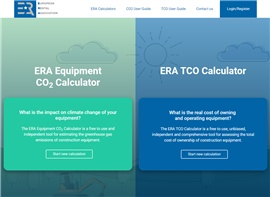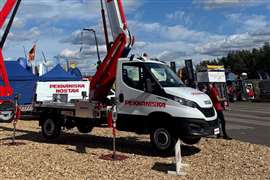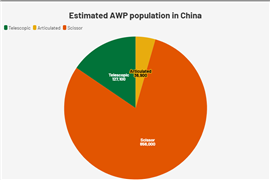Read this article in French German Italian Portuguese Spanish
Case bets on electrification, autonomy and rental expansion to navigate market headwinds
24 June 2025
Case Construction’s remote-controlled Impact concept electric wheel loader is the latest manifestation of the company’s strategic vision to focus on machine autonomy, electrification and a rapidly expanding rental market. Fabrizio Cepollina, the company’s head of construction equipment for EMEA, tells Lewis Tyler how the approach is designed to meet tightening environmental regulations, shifting customer behaviour and mounting global trade pressures.
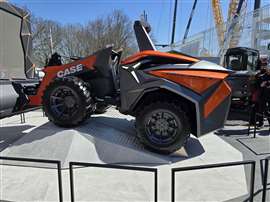 Case Construction’s autonomous electric compact wheel loader concept. The electric Impact machine is based on its eCWL 12EV wheel loader
Case Construction’s autonomous electric compact wheel loader concept. The electric Impact machine is based on its eCWL 12EV wheel loader
Accompanied by a soundtrack with a thumping base, a man wearing a black hoodie emblazoned with the words “Let’s Drive the Future,” uses a device rather like a games console to remotely drive a wheel loader around a building site at night.
The latest video used to promote Case Construction’s Impact concept, one of the most talked about construction equipment innovations unveiled at this year’s Bauma exhibition, demonstrates how the unit eliminates the traditional cab and is designed to be remotely operated from a nearby cabin or “control lounge.”
Remote control machinery
“Remote controlling is an application that is already utilised in other industries,” says Fabrizio Cepollina, the company’s head of construction equipment for EMEA. “Thinking about the dangerous environments [on construction sites], we believe it can be furthermore developed for construction.”
The Impact concept, based on the company’s eCWL 12EV, integrates semi-autonomous features for digging and dumping, coupled with a perception system that enables real-time environmental sensing—advancements aimed at improving both consistency and operational efficiency.
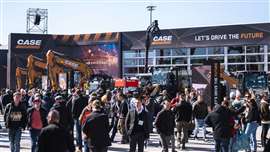
Although not intended for immediate mass production, the Impact serves as a proving ground for a range of technologies Case plans to roll out in the near to medium term. “It’s a concentration of new technologies and innovations,” said Riccardo Balma, compact equipment product manager, all of which are either validated or currently undergoing testing.
While automation captured headlines, electrification is a more immediate trend. Its compact electric product line, led by the 3.8-tonne 12EV loader with a 23kWh battery, is aimed at urban useage where noise and emissions regulations are stricter—and where access to charging infrastructure is less of a concern.
“We consider electric an opportunity,” says Cepollina. “Also, looking at the green economy in Europe, we are matching the requests in terms of government direction.”
Following earlier electric mini excavators—the CX15EV and CX25EV—Case launched the 580EV backhoe for the North American market. “We see the electric units more in urban areas,” adds Cepollina, “but they can also be easily recharged.”
Moog collaboration
Larger machines, however, present a technological and economic challenge. Battery costs and charging capabilities remain significant barriers, but Case has taken a step forward through its collaboration with US-based precision control systems manufacturer Moog. The CX210ZQ, a full-size electric excavator, uses Moog’s ZQUIP modular battery system, which allows for rapid swaps and minimised downtime.
“On the heavy line we have this opportunity with Moog,” Cepollina explains. “It will depend also on the evolution of the technology in the coming years in terms of cost of the battery and the capability of the battery to be recharged quickly.”
 Fabrizio Cepollina, head of Construction Equipment for EMEA, CASE Construction
Fabrizio Cepollina, head of Construction Equipment for EMEA, CASE Construction
He also notes that other technologies, including hydrogen, are under consideration. However, Cepollina remains cautious. “There are discussions about hydrogen—also for other sectors, for example, for the truck business,” he says. “But there are still some question marks around hydrogen because it’s about how to manage it.” Efficiency and infrastructure, he adds, are two major limitations.
While Case continues to invest in product innovation, it is also betting heavily on rental as a long-term growth strategy—especially in Europe, where a construction market slowdown and macroeconomic uncertainty are shifting customer behaviour.
The company, alongside its financial arm CNH Capital, has expanded its rental offering through a new ‘rental mechanism’ programme that allows dealers to offer long-term rentals of 24, 36, 48 or 60 months and bases the value of the machines on their commercial – and not their financial value. The approach has already yielded results.
“In general, we see that rental is growing everywhere,” says Cepollina. “We are helping our dealers and stimulating them to have all the possibilities to operate with the rental division.”
Today, rental accounts for roughly 20% of CNH Industrial’s total construction and agricultural equipment sales. “We recognise that we can push more, but we grew a lot in the last year and half,” he adds, pointing to strengthened partnerships with rental companies and increased dealer activity in the space.
Rental growth
He frames rental growth within a broader cultural shift toward service-based consumption. “In all types of business, the product is becoming more and more immaterial,” he says. “In the past, the focus was on ownership. Today, particularly in Europe and other developed markets, customers are buying a service—buying a package that includes what they need to get the job done.”
He argues rental aligns perfectly with that model: “Rental will give you the flexibility that you need to face a dynamic market anticipation.”
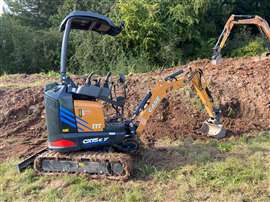 The CX15EV electric mini excavator
The CX15EV electric mini excavator
Beyond technology and business model evolution, Bauma 2025 also reflected the mounting pressures from trade disputes and protectionist policies. For Case, the rising tariffs on construction equipment—particularly those affecting Chinese manufacturers—pose both challenges and opportunities.
“It seems the strong message behind this tariff situation is a request—a need—for negotiation between governments and states about the future of industrial policy: where to produce, how to produce, and under what conditions,” says Cepollina.
Case has mitigated some of the volatility thanks to a diversified manufacturing base. Roughly 55–60% of its European demand is served by regional plants. “We don’t import from China, and we’re not actively selling in China,” Cepollina explains. “The flow of products is multipolar—we produce in North America, Latin America, Europe, and India.”
The impact of tariffs
This footprint enables a degree of flexibility, but not immunity. “In the medium term, tariffs can be partially absorbed by manufacturers or governments, but the first direct impact is on price,” he notes. “I don’t think tariffs can be completely absorbed, so it depends on how nations conclude these negotiations.”
He acknowledges that companies without local production facilities in key markets—particularly North America—may face cost pressures, potentially giving Case a modest advantage. “The only benefit I see is that some producers without a footprint in North America, for example, will face more difficulty. They’ll be obliged to raise prices.”
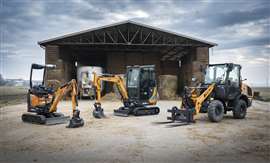 Photo: CASE
Photo: CASE
The first half of 2025 has brought mixed signals. While some anticipated a rebound in European construction this year, markets in Germany and France remain subdued amid geopolitical tensions and delays in public infrastructure spending.
“There was an expectation that the market in 2025 would grow versus 2024, depending on the country. But now, due to tariffs and geopolitics, the market in some areas like Germany and France were down on the first part of the year,” says Cepollina.
Nonetheless, he is cautiously optimistic. “We’re seeing government programs that could boost the economy—particularly infrastructure spending. Residential might be slower, but Q2 and the second half of the year could bring recovery, even if 2025 ends up being flat overall.”
Elsewhere, the company sees positive momentum in emerging markets such as South Africa and the Middle East, driven largely by infrastructure demand.
He expects 2026 could offer more sustained improvement, though he anticipates uneven recovery across markets. “Between now and then, we expect some countries will grow, others may decline—a bit of a reshuffle. But no major growth against 2024.”
STAY CONNECTED



Receive the information you need when you need it through our world-leading magazines, newsletters and daily briefings.
CONNECT WITH THE TEAM









